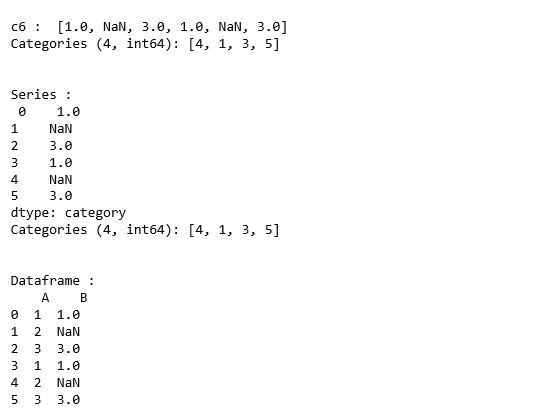pandas.Categorical(val, categorias = Ninguno, ordenado = Ninguno, dtype = Ninguno) : Representa una variable categórica. Categóricas son un tipo de datos pandas que corresponde a las variables categóricas en las estadísticas. Tales variables toman un número fijo y limitado de valores posibles. Por ejemplo: calificaciones, género, tipo de grupo sanguíneo, etc.
Además, en el caso de las variables categóricas, el orden lógico no es lo mismo que los datos categóricos, por ejemplo, «uno», «dos», «tres». Pero la clasificación de estas variables utiliza un orden lógico.
Parameters- val : [list-like] The values of categorical. categories : [index like] Unique categorisation of the categories. ordered : [boolean] If false, then the categorical is treated as unordered. dtype : [CategoricalDtype] an instance. Error- ValueError : If the categories do not validate. TypeError : If an explicit ordered = True but categorical can't be sorted. Return- Categorical variable
Código:
Python3
# Python code explaining
# numpy.pandas.Categorical()
# importing libraries
import numpy as np
import pandas as pd
# Categorical using dtype
c = pd.Series(["a", "b", "d", "a", "d"], dtype ="category")
print ("\nCategorical without pandas.Categorical() : \n", c)
c1 = pd.Categorical([1, 2, 3, 1, 2, 3])
print ("\n\nc1 : ", c1)
c2 = pd.Categorical(['e', 'm', 'f', 'i',
'f', 'e', 'h', 'm' ])
print ("\nc2 : ", c2)
Producción :

Python3
# Ordered = True
c3 = pd.Categorical(['e', 'm', 'f', 'i',
'f', 'e', 'h', 'm' ], ordered = True)
print ("\nc3 : ", c3)
Producción :

Python3
# Mixed categories
c4 = pd.Categorical(['a', 2, 3, 1, 2, 3])
print ("\nc4 : ", c4)
c5 = pd.Categorical(['a', 2, 3, 1, 2, 3], ordered = True)
print ("\nc5 : ", c5)
Producción :

Python3
# using categories attribute
c6 = pd.Categorical([1, 2, 3, 1, 2, 3], categories = [4, 1, 3, 5])
print ("\nc6 : ", c6)
print("\n\nSeries : \n", pd.Series(c6))
df = pd.DataFrame({"A":[1, 2, 3, 1, 2, 3]})
df["B"] = c6
print ("\n\nDataframe : \n", df)
Producción :

Publicación traducida automáticamente
Artículo escrito por Mohit Gupta_OMG 🙂 y traducido por Barcelona Geeks. The original can be accessed here. Licence: CCBY-SA